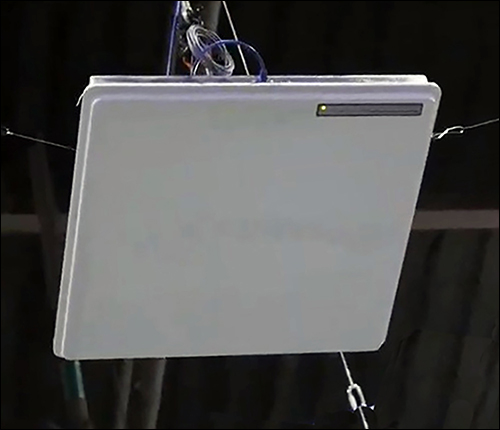Confidex, a maker of RAIN UHF RFID-enabled logistics labels and container tags, and RF Controls have partnered to offer a real-time passive UHF RFID solution that consists of RF Controls’ new CS-445B UHF real-time location system (RTLS) reader and Confidex’s tags. The system can identify the locations of tagged items within zones, with a granularity of about 18 inches. RF Controls designed its RTLS reader to provide asset- and inventory-tracking solutions with UHF RFID tags tracked in real time.
The reader solution enables users to view where goods are located as they move around a space, and to create zones to trigger or enable specific actions, says Adrian Turchet, RF Controls’ senior VP of strategy and corporate development. At a store, for instance, a user could set up a zone around the point of sale to identify goods being purchased. The Power-over-Ethernet (PoE) reader comes with a bidirectional, steerable array CS Smart Antenna to identify tags’ locations, and the company finds the system works well with Confidex’s Crosswave UHF RFID tag, according to Joe Hoerl, Confidex’s sales director for smart industries in North America.
“We’re tag-agnostic,” Turchet says. “We like to test all available tags.” The reader works with any UHF RFID tag, he adds, but the company found that the Crosswave tags worked well with the RTLS solution. “The Crosswave labels are designed to be read from a 360-degree orientation,” Hoerl says, meaning they can be captured even as they move or change orientation.
The two companies demonstrated the solution at this month’s RFID Journal LIVE! conference, held in Phoenix, Ariz., and the CS-445B won the Best New Product award in this year’s RFID Journal Awards. The CS-445B has a 45-foot read range, RF Controls reports. It is designed to be suspended from ceiling heights ranging from 10 to 30 feet, the company adds, and it operates best at a height of 22 feet. Therefore, the system works well at large box retail locations, as well as at distribution centers and assembly sites.
The system can cover an area of up to 900 square feet of space when installed horizontally at a height of about 15 feet, and can be angled to read tags further away by extending its scan area. It has the ability to triangulate using one or more antennas to provide tag reads in three dimensions. For instance, if a company has racks of goods stacked vertically, the solution can identify the height at which each item is stacked. The software also enables businesses to set up zones in which to track movement and trigger actions accordingly. For instance, they could view when workers enter unauthorized areas, or when inventory is moved into a staging area.
The CS-445B operates with a single antenna that uses algorithms designed by RF Controls engineers, according to Alex Gaddie, the company’s chief software engineer. The reader emits a single beam of energy, as opposed to similar overhead UHF RFID readers that employ numerous antennas in a single device (or connected to that device). The antenna can accomplish circular, horizontal and vertical polarization, he explains. Additionally, Gaddie notes, the system is designed to be easy for users or integrators to configure, and comes with a drag-and-drop user interface to speed up the deployment process.
The technology could be employed for such functions as tracking large numbers of goods or vehicles throughout a distribution center. In such an environment, goods pass through the facility, often dwelling at a given spot for only a matter of minutes or hours. As such, tracking those items’ locations can help a company not only to identify items in real time, but also to collect analytics regarding the efficiency of their processes and receive alerts if something is incorrectly loaded and missed during loading.
Based on the reader’s functionality and cost, the company reports it can provide real-time data at a lower cost per square foot than other RTLS solutions. With the real-time data collected from the reader, Turchet says, DCs and other companies can better manage the scheduling of their processes, as well as optimize workers’ productivity based on data indicating where they are at any given time.
Once the system is in place, Turchet says, companies can begin tagging anything or anyone that moves through a designated area, including personnel, inventory and assets, down to lunch boxes and safety vests. It can also be utilized for route optimization of forklifts. What’s more, the technology could be deployed in a retail environment to monitor inventory, customer interactions and shopping carts, for instance.
With the new RTLS reader, Turchet explains, end-customers can tag goods and achieve a higher return on investment “driven by low-cost, battery-free tags, higher ceiling environments and easy-to-install overhead passive RTLS, previously not possible without a CS Smart Antenna.”
Later this year, the company expects to have a number of large projects under way in the logistics sector. By the second quarter of 2019, Confidex expects to release products optimized for shipment verification. RF Controls, meanwhile, has launched two Internet of Things (IoT) labs to develop logistics, manufacturing and retail use cases for the RTLS solution. The labs are located at the University of Quebec’s Montreal School of Business and the GreenUX retail living lab.
“Finally, passive RTLS has come to market,” says Ygal Bendavid, a UQAM ESG professor and its director of IoT. He says he expects a wide variety of applications for the technology, adding, “Besides logistics and warehousing, I see huge opportunities in manufacturing, connected retail and hospitals.” Going forward, he reports, “We are eager to implement CS Smart Antennas in our labs and transfer the knowledge to end-customers for the future of passive RTLS and their ability to enrich artificial-intelligence systems.”


